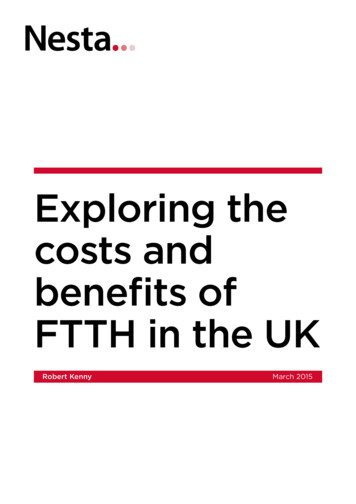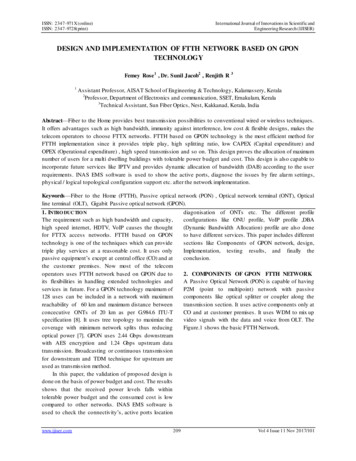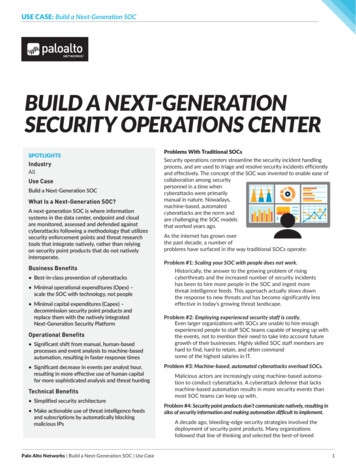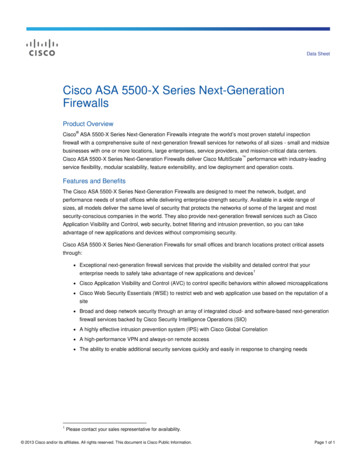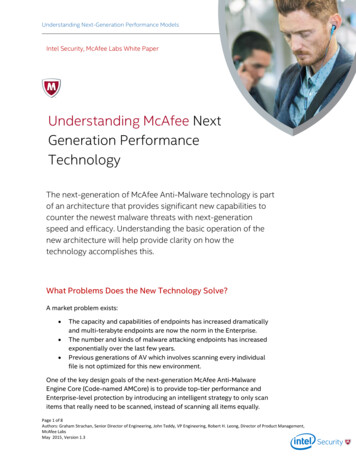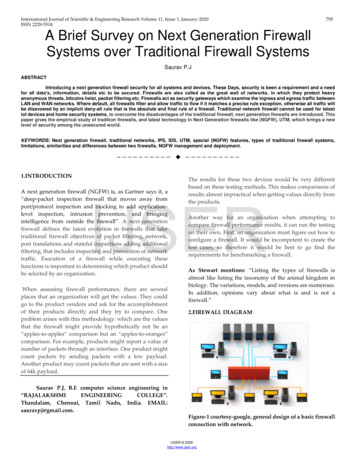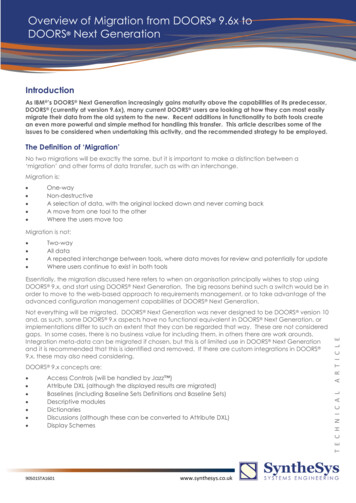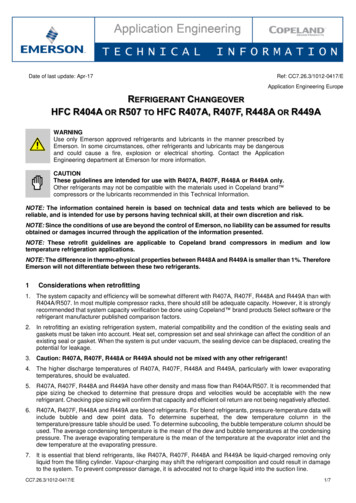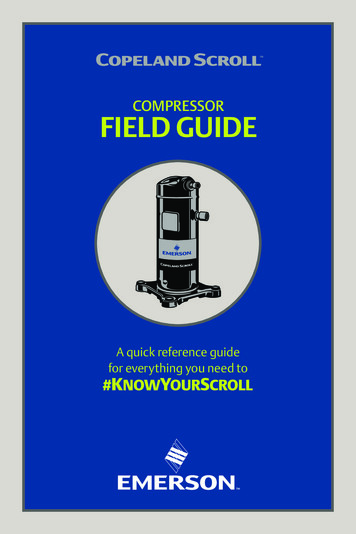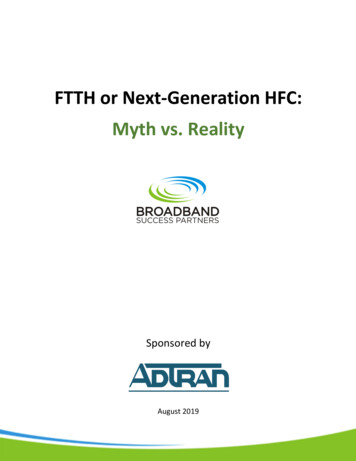
Transcription
FTTH or Next-Generation HFC:Myth vs. RealitySponsored byAugust 2019
FTTH and Next-Generation HFC: Myth vs. RealityJack Burton, Principal, Broadband Success PartnersIntroductionCable networks are already the preeminent platform for transmission of data services for bothresidential and business customers. Lately, however, there is speculation that new networks, perhapsdriven by next-generation wireless advances, will be required to fulfill anticipated needs.How can cable be ready for this transition? One way might be through what I will call “Next-GenerationHybrid Fiber Coax” (NG HFC), which includes the up and coming technologies of Distributed AccessArchitecture (DAA), Node 0, Full Duplex Data Over Cable Service Interface Specification (DOCSIS) (FDX),Extended Spectrum DOCSIS (ESD), and Virtual Cable Converged Access Platform (vCCAP). Another waycould be via Fiber-to-the- Home (FTTH) technology (including Fiber to the Business) involving PassiveOptical Networks (PON). How is an operator to decide which is best, and what should they be doing nowto be prepared for that decision?MSO Legacy ArchitectureMost Multi-Service Operators (MSOs) have an HFC infrastructure serving 500 homes per node today.(Figure 1) Maximum cascades typically range from three to five amplifiers beyond the node. Speedpeaking close to 1 Gbps downstream is possible if enough downstream spectrum is devoted to DOCSIS.No major operators, however, have changed their upstream split to permit speeds higher than about100 Mbps. The reasons behind why the upstream split has not changed offer a clue into the futurechallenges of Next-Generation HFC (NG HFC). However, before analyzing the reasons, let us firstexamine the different network options.Figure 1-2-
New Network OptionsHFC NetworksNode 0 (Node 0)To take speeds significantly higher than possible with 500-home nodes, dropping the service group sizeto numbers similar to PON (32, 64, or 128 homes) is required. (Figure 2)Figure 2Further, current lab implementations of FDX and ESD require Node 0. FDX or ESD will permit theupstream speeds to rise to 1 Gbps symmetrical service and beyond.Distributed Access Architecture (DAA)Remote Physical Layer (Remote PHY) or Remote Media Access Control and Physical Layer (Remote MACPHY) define the Distributed Access Architecture (DAA). DAA solves many MSO challenges. By putting themajority of headend equipment into the field, space and power in the headend become available forother purposes. Indeed, without DAA there would probably be insufficient space and power in theheadend to support the number of new nodes required for Node 0.Combining DAA and Node 0With DAA, Quadrature Amplitude Modulation (QAM) signals are generated at the node. They need notpass through amplifiers before or after hitting the coaxial network, and therefore when combined withNode 0, higher-order modulation can be used than would be possible with a conventional analog fibersystem. Going from 1024 QAM to 4096 QAM can produce a 30 percent increase in throughput!MSO ProvisioningMSOs have a well-established DOCSIS infrastructure. This allows not only easy flow-throughprovisioning, but in many cases customer self-provisioning of modems available via retail outlets. Theservers in the background that permit modems to come online, receive walled-garden services, obey-3-
lawful intercept orders, etc., are part of the network. Future DOCSIS iterations, such as FDX, promise tomaintain this infrastructure’s utility.VirtualizationVirtualized Converged Cable Access Platform (vCCAP) has the potential to replace the computingsystems contained within Cable Modem Termination System (CMTS) equipment with generic off-theshelf “blade server” technology. This could enable new players to enter what had been an exclusive clubof CMTS vendors while also shrinking the size of the CMTS equipment required in the headend. It canalso help enable third-party suppliers of plant equipment through standardized interfaces with thoseservers.Fiber NetworksPassive Optical Networks (PON)PON allows service to many (32, 64, or up to 128) homes over a single fiber. The fiber is brought to aneighborhood where a passive splitter network is used to feed the homes or businesses. (Figure 3)Figure 3Variations of PON standards permit speeds of 10 Gbps or more to be delivered. PON, in one form oranother, is the standard method of delivery for FTTH networks today.DOCSIS Provisioning of EPON (DPoE) leverages MSO Provisioning to render the Optical Network Unit(ONU) a facsimile of the DOCSIS cable modem.Radio Frequency over Glass (RFOG)RFOG places what amounts to an analog fiber node at each serviced home. RFOG has lost favor lately:Not only is analog transmission of optical signals not typically able to accommodate the optical lossrequired to serve service groups of more than 32 homes, but if cable modems transmit simultaneouslytheir optical carriers could interfere with one another when transmitting on the same wavelength. A-4-
limited RFOG overlay to a PON is still used, however, to achieve compatibility with an installed base ofRF-QAM video set-top box equipment.A Tier-2 MSO with over 35,000 RFOG customers is now beginning the process of converting customersto PON.Similarities between FTTH and NG HFCWhether a network is FTTH or NG HFC, signals must travel from the headend to the neighborhood beingserved. In the case of a PON, each service group has a splitter that must be fed by the Optical LineTerminal (OLT). In an HFC network, each service group requires a node output.If the legacy fiber to the neighborhood does not contain enough fibers to feed all of the service groups,either more fiber must be installed or a Dense-Wavelength Division Multiplexing (DWDM) system orRemote OLT is required. The network architecture up to this point is identical between the PON and NGHFC networks.Transport PlantLet us consider the transport requirements for a typical area served by a legacy 500-home fibernode. If we convert this area to a 32-home per splitter PON, we will require at least 16 fibers. Ifinstead we replace typical 12-line extender amplifiers fed by that node with new DAA nodes,including the legacy location, we require 26 fibers (separate upstream and downstream).To be ready for 5G, a pro-active MSO may wish to add fibers to feed future small cell locations.If we assume that each splitter or DAA node location will have one fiber-fed 5G radio location,the number of fibers required could double versus just feeding the new Node 0 nodes. Theonly practical way to solve this problem is with DWDM.A field-mounted DWDM multiplexer could serve one or more legacy node locations, dependingon factors including the number of wavelengths available, locations available, and the amountof fiber desired to be constructed from the multiplexer to the new node or Remote OLTlocations.The transport problem is the same for both NG HFC and FTTH installations – too few fibers to aneighborhood is corrected via DWDM networks or additional fiber construction. If FTTH isused, the DWDM network must feed remote OLTs to generate the PONs.Differences between FTTH and NG HFCFrom the distribution point to the home is where FTTH and NG HFC networks differ. With PON, splittersare deployed between the OLT and PON neighborhoods of typically 32 to 128 homes. A high-densitysplitter is adjacent to the remote OLT or multiple small-scale splitters working in cascading fashionaccommodate both greenfield and brownfield applications. In an NG HFC system, fibers feed each nodelocation and then a coaxial network feeds a tap near each home. Coaxial drops are installed from the tapto the home.-5-
The coaxial network requires power to operate the nodes, and if amplifiers beyond the node are usedthose require power too. Power supplies are installed that transform local utility power into a lowervoltage and apply this to the coaxial plant. If the FTTH network uses remote OLTs, these devices requireutility and standby power.DropsFTTH networks require optical drops to each customer premise. At each premise, a gatewaydevice terminates the fiber and enables digital service for customer equipment via Ethernet,Multimedia Over Coax Alliance (MOCA), or Wi-Fi.While NG HFC networks use existing coax drops, numerous component upgrades may beneeded to move from legacy HFC to NG HFC (details forthcoming).Active electronics in field for DAA/Node 0NG HFC and PON can serve relatively close customers from the head end and hub and relativelydistant customers from the remote cabinet or remote node. The geography of a particularapplication will determine whether NG HFC (node, amplifiers, taps) or Node 0 (node, taps) aremore efficient.Limitations imposed by FDX echo-canceling operation may require Node 0.If a remote OLT PON is used, that is active electronics in the field for FTTH.RF delivery unavailable for FTTH unless an RFOG overlay is employedWhile RFOG networks carry existing RF services as-is, in PON networks, RF services are notavailable. Any service previously delivered via RF, such as QAM TV, would need to be replacedby IP TV service (IPTV). RFOG overlays can be used to get around this problem but at the cost ofadditional equipment and significant design complexity. A VP of Network Architecture andStrategy at a Tier 1 MSO noted “RFOG needed groups of 16, in some cases, due to lower lossbudget.”RF services, such as those used to feed legacy video set-top boxes with QAM signals, areanticipated to continue as-is in NG HFC networks. This may or may not be the case in reality, asa gateway approach in the home may be required to enable some of the new technologiesplanned.Whether FTTH or NG HFC, operators should prepare to invest heavily in their networks to both competewith 5G operators and to attract those same operators as their customers. The fiber transport networkrequired for either option is basically the same, and construction of it should begin now, even if theoperator has not decided whether their future access network will ultimately be coax- or fiber-based.-6-
FTTH or Next Generation HFC: Myth vs. RealityFTTH has held the promise of high bandwidth, reduced plant operations and maintenance cost, superiorreliability and quality, and, more recently, comparable construction costs.Despite all of the advantages of FTTH, few major MSOs in the United States have fully embraced it. Thepremise that FTTH networks are far costlier than HFC network upgrades is widely accepted. Why is this?Let us examine some of the long-held beliefs about FTTH relative to NG HFC versus the facts.Here are the factors to consider, in order of importance:1. Maintenance2. Disruption of Service3. Construction4. Terminal Equipment5. Apartments6. Training7. ProvisioningSince the life expectancy of these networks is in excess of ten years, these factors have been prioritizedbased on their comparative importance over a fifteen-year period.1. MaintenanceFiber NetworkFiber networks require no routine or preventive maintenance. “HFC maintenance was runningabout 1,100 per mile per year, with over half being for power alone. In areas we converted toFTTH, our budget dropped to 100 per mile per year”, according to the Tier 1 MSO VP ofNetwork Architecture and Strategy.“HFC maintenance was running about 1,100 per mile per year,with over half being for power alone. In areas we converted to FTTH, ourbudget dropped to 100 per mile per year.”VP of Network Architecture and Technology, Tier 1 MSOThe cost of ongoing maintenance over a ten- or twenty-year period for a coaxial system cannegate the capital cost savings of constructing one when compared to a FTTH system wheremaintenance costs approach zero.-7-
Coax NetworkCoaxial networks require routine preventive maintenance and require ongoing power expense.Signal leakage must be detected and measured, and any leaks repaired. Higher plant bandwidthmakes it necessary to detect leaks at multiple frequencies, exposing the plant to ingress fromnew sources such as small-cell radios. Connectors, if damaged or installed improperly, can allowwater intrusion and corrosion, which will impair performance and can cause outages. Powersupply batteries must be maintained. Signal levels must be carefully monitored and maintained,and may involve status monitoring networks or manual field checks.Advantage FTTH. FTTH is far easier and less costly to maintain than NG HFC. Over time thefinancial advantages are very significant.2. Disruption of ServiceIt is important to not only consider the cost and difficulty of deploying a network in terms ofequipment dollars and man-hours of labor. Customers are connected to the legacy network!Their service must be disrupted as little as possible.Myth: I can upgrade my coaxial network with minimal disruption to my customers by doing soout-of-hours and carefully scheduling replacement of plant equipment.Reality: When an HFC network is upgraded, network interruptions are required. These can beminimized through careful planning. However, they will still happen. Each service interruptionannoys customers and makes them more likely to switch to a competitor.Changing to a Node 0 or DAA network requires equipment replacement that will cause allsubscribers to lose service during the equipment change.Changing to a high-bandwidth (ESD) network will involve changes in the passive outside plant.Subscribers could lose service multiple times if taps are changed and might need to have theirproperty visited when drop cables are replaced.Changing terminal equipment is the most disruptive activity of all, because each customer mustbe visited, which means an appointment must be made often requiring the customer to misswork. FDX may require terminal equipment changes even for homes not using FDX services.Advantage FTTH. FTTH networks can be overbuilt alongside an existing HFC network with nodisruption to existing customers. When terminal equipment must be changed, it is forcustomers taking the new FTTH service only. Eventually, all customers on the HFC network couldbe changed over at their convenience.3. ConstructionMyth: Building FTTH networks requires not only replacement of all Outside Plant (OSP) coaxialcable with fiber cable, but also replacement of cable drops to each home with fiber drops. Insidethe home, fiber must be brought to the optical terminal equipment location, and that location-8-
requires power and access to any in-home wiring required to service the devices. Because all OSPcoaxial cable must be replaced by fiber, there is no opportunity to reuse expensive portions ofthe coaxial network, such as areas of underground construction and apartment building wiring.Reality: New types of fiber cable minimize construction costs by being able to be handled withlittle regard for overstressing through pulling or bending. There are systems available to removecoaxial cable dielectric and core, and use the remaining shield as a duct for air-blown fibers. Ifthe coax was installed in conduit, new techniques for adding flexible subducts and usingmicrosize fiber cables can sometimes allow installation of fiber in an occupied duct.The difference in underground construction cost varies with the amount and complexity of theparticular network. An operator with mostly aerial cable will be less concerned than an operatorwith mostly underground cable, particularly if the underground cable is buried in an urbanenvironment.A CTO from a Tier 2 MSO using FTTH for years said, “The things you’re doing for FTTH or FiberDeep are the same until the drop to the house, and starting 2 years ago, we future-proofed [thatconcern] with Siamese coax/fiber drop. Going to Node 0 would have similar constructionchallenges without the ability to use microfiber where coax is required.”“Going to Node 0 would have similar construction challengeswithout the ability to use microfiber where coax is required.”CTO, Tier 2 MSOWithin a building, very small fiber cables designed for use in hallways are available, eliminatingthe need to penetrate apartments not subscribing to the fiber service. “Invisible” fiber isavailable to allow running fiber within apartments in the corners between walls and ceilingsmaking “wall fishes” unnecessary.A VP of Engineering from another Tier 2 MSO stated that in their case of building Node 1 andDAA, that cost is lower than FTTH. In greenfield cases, costs are comparable.What about the construction cost for NG HFC networks? It is true that when upgrading thenetwork, the hardline plant cable itself will remain intact in most cases. The RF amplifiers maybe replaced by new DAA fiber nodes for conversion to a Node 0 architecture. These new fibersmust be constructed back to a distribution point, typically located at the original node location.This is the construction that operators anticipate. If the network bandwidth is increased duringthe NG HFC upgrade, however, (And who doesn’t want to increase network bandwidth duringan upgrade?), unanticipated additional construction may be required. The upcoming DOCSIS4.0/Extended Spectrum DOCSIS (ESD) specifications will likely include bandwidth expansionoptions to 1.8 GHz and beyond along with FDX.Tap PlatesChances are at a minimum the values of tap plates will need to be changed toaccommodate high-output RF levels from NG nodes (and perhaps NG amplifiers) and-9-
new plates will be required to pass the new ESD frequencies. Tap changes toaccommodate FDX echo cancelation are not anticipated but are a possibility.Tap HousingsWill the existing tap housing be able to perform adequately at the new frequencies? Theentire housing may need to be replaced at each tap location. This is huge both in termsof expense and the outages it will create during construction.Drop CablesWill an existing RG-6 drop running 100 feet be adequate to deliver a top frequency of1.8 GHz? If the network is changed to a “Home Gateway” architecture and splitters atthe home are not a concern, the answer is likely yes. What about 3 GHz? What if thedrop is 150 feet? If this is the case, larger, more expensive and harder to handle RG-11may be required.PowerThe coaxial network, before an upgrade, has power to feed the existing amplifiers. Whathappens if the amplifiers are replaced by DAA nodes, typically with a high-level RFoutput? The power consumption, and thus the need for power supplies and theelectricity that feeds them, will likely increase.AmplifiersMost existing amplifiers in the legacy network cannot accommodate the high leveloutput of a DAA node (because of the high tilt required for ESD frequencies).Considering a Node N infrastructure may only be possible without a significantbandwidth extension.Fiber Trunk InfrastructureThe amount of spare fibers at the legacy node locations is usually quite limited. Theresimply are not enough spares to feed more than a dozen new nodes to replace existingamplifiers.Either a new trunk from the headend with new fibers must be built, or a DWDMinfrastructure must be constructed using the limited available spare fibers. The newDWDM network would then be used to feed the new nodes. The need for new fibers iswell known for FTTH networks, but it is just as important for NG HFC networks involvingNode 0.Advantage FTTH. FTTH is easier to construct than NG HFC in most cases. In particularlyexpensive areas, such as urban underground, if the coax is already in place, NG HFCwould be preferable when the buried plant can be reused. On the other hand, thehidden costs of upgrading NG HFC networks for DOCSIS 4.0/ESD technologies such as1.8 GHz, 3 GHz, or FDX can make it very expensive.- 10 -
4. Terminal EquipmentMyth: With a PON, there is no RF infrastructure; the only means to deliver video service is viaIPTV. Most currently deployed set-top boxes only support RF-delivered QAM video and wouldrequire replacement. This replacement is not necessary with NG HFC. (Figure 4)Figure 4Reality: The popularity of Over-The-Top (OTT) services illustrates that operators and customersalike are already coming to terms with IPTV. Many operators have created IPTV facilities toserve video to tablets, laptop computers, and phones. The IPTV network can be expanded toserve IPTV set-top boxes. IPTV set-top boxes cost far less (generally speaking) than RF-QAM settops, and could even be provided by the customers in the form of software available with“Smart TV” sets or the Amazon Fire TV Stick.Replacing terminal equipment in the form of TV set-top devices is not only a fiber networkrequirement, it may be a side effect of an NG HFC deployment as well. (Figure 5)- 11 -
Figure 5When bandwidth is expanded, most NG HFC upgrades will require that the home be convertedfrom an extension of the cable network into a stand-alone network fed via a home gateway. Thisis because legacy equipment in the home tied in to the cable network would not functionproperly with an altered downstream/upstream split in the plant or other equipment in thehome operating in Full Duplex DOCSIS mode. All of this existing equipment must be isolated orreplaced. Once isolated, how would the legacy box receive its signals? Most legacy RF set-topboxes cannot function without pilot signals from the plant.In an isolated network, Home Video Gateways terminate data and video services. They thenfeed “mini” boxes at other TVs in the home via Multimedia over Coax Alliance (MOCA),Ethernet, or Wi-Fi. In other words, new set-top boxes. It may not be necessary to changeequipment in homes that are NOT receiving upgraded services; however, this is not certain.To take full advantage of the extra upstream bandwidth made available by NG HFC, terminalequipment must be replaced just as it must be with FTTH. Blaming the cost of terminalequipment replacement on fiber is a red herring. Don’t ignore the hidden costs of NG HFC.In an FTTH network, it is expected that terminal equipment will be required. (Figure 6)- 12 -
Figure 6Referring to his deployment in Central Florida several years ago, the Tier 1 MSO VP of NetworkArchitecture and Strategy put it this way, “Marketing teams had to have full feature parity whichdrove the RFOG overlay. This added about 160 per home cost. Today, things are different, andIPTV is possible. “No Advantage. The myth is that NG HFC will be way ahead because of the ability to continueusing legacy terminal equipment. In reality, we have a tie because it is likely that both FTTH andNG HFC will require terminal equipment replacement.5. ApartmentsMyth: Replacing coaxial drops to each home in a Multi-Dwelling Unit (MDU) with a fiber drop isa daunting task to contemplate. The costs of drop replacement can run several hundred dollarsper unit, and require a high level of disruption, despite the promise of fiber-optic service. 5Gcompetitors stand ready to offer high bandwidth to each unit from the outside-in, withoutradically re-wiring the building. I must use my existing coax and compete somehow. These sameconcerns apply to multi-unit commercial buildings we also serve.- 13 -
Reality: Many apartment buildings have homerun coax available to each unit from a central lockbox in each building, or on each floor. If fiber is run to this location, a centralized PON terminalcould provide service to each unit over copper. Bandwidth may be limited, and specializedequipment will be required, but the cost of such a service should be much lower than rippingout the coax and replacing it with fiber. Standards such as MOCA, G.hn, or G.fast over Coax areavailable to facilitate these deployments. (Alternately, the operator could use the sametechniques as its competitors to offer service via microwave from fiber-fed terminals locatedoutside.) The Tier-2 MSO CTO reports, “We have successfully been using MOCA fed by ourstandard ONT to deliver service to apartments in a two-box solution”.If running fiber to apartments is the decided course, newer techniques and equipment can makethis less costly than would previously have been the norm. “We are experimenting with tinyfiber trays run in apartment hallways for real FTTH in each unit for new buildings,” the Tier 2MSO CTO said. Tiny cables and “invisible” ultra-bendable fibers to eliminate “wall fishing” arenow available.No advantage. Coax infrastructure in apartments can continue to be used with NG HFC,however if bandwidth is greatly expanded or upstream/downstream splits are altered, the inbuilding network might need to be re-built for the new coax network. Radio access, on theother hand, requires no work inside the apartment building at all. FTTH systems can re-usehome run cables with coax adapters, and new techniques make fiber wiring less expensive thanever before.A 5G/mmWave network feeding apartments from the outside-in is one way to serve an MDUwithout rewiring the building, but the serving radios would likely be fed with fiber.6. TrainingMyth: Any technician handling fiber will require special training because handling fiber is viewedas more complicated than handling coaxial cables. Technicians may also require specialized fibertools such as fusion splicers and Optical Time Domain Reflectometers (OTDRs).Reality: Handling fiber drops themselves is really no more difficult or complicated than handlingcoaxial cable. “The training for FTTH is not any more difficult than for HFC, just different,”according to a Tier-2 MSO VP of Engineering. Putting on connectors does require special tools,but once a technician is trained the level of difficulty is similar. To avoid connectors, fusionsplicing is now available for the street-side plant, in the drop connection, and in the home. Lowcost automated portable equipment makes fusion splicing for all connections (at least otherthan to the optical equipment) not only possible, but practical. Because fusion-splicedconnections are permanent, one need not worry about re-mating connections letting dirt get inor connectors get damaged – an ever-present problem with fiber connectors.An optical power meter is much easier to use than an RF signal level meter (as tuning is notinvolved, and an OTDR operates in the same manner as a copper TDR. Yes, training is required,but it is required for its copper counterparts as well.- 14 -
It is also becoming increasingly difficult to find the talent for coaxial construction. The Tier-2MSO CTO said, “It’s hard finding people to splice coax! All of our field techs are trained in fusionsplicing, including installers.”Advantage NG HFC. Since there is some new training required for FTTH, NG HFC where HFC isalready in place would be easier. In greenfield situations, this is a tie.7. Provisioning and Back-office InfrastructureMyth: Bringing an ONT online via established “telco” methods often involves procedures that areforeign to most cable operators. Older PON systems generally require that a specific ONT bebrought online ONLY when that home is tied to an account and given some level of service. Bycontrast, many MSOs allow any DOCSIS modem to be connected and automatically be broughtonline in a “walled-garden” state. That modem can then be attached to an account and providedwith Internet service by direct interaction with the walled-garden servers, often by the customer.Telco systems involve back office communication via Netconf or XML rather than DOCSIS. (Thesemethods may be preferred by some cable operators) Lastly, I won’t be able to use myPacketCable voice infrastructure to deliver voice on an FTTH network.DOCSIS infrastructure allows all of the housekeeping necessary for a cable modem service,including lawful Intercept of data and voice, encryption and privacy of data, Domain NameService (DNS), Time of Day (TOD), etc. PON systems generally cannot use these DOCSIS tools.These items would need to be handled externally.Reality: Yes, traditional PON is not DOCSIS. The vendors have noticed this, as have standardsbodies such as CableLabs. Several years ago, the idea of DOCSIS provisioning of EPON gainedsome traction. Operators could use the same commands they send to their CMTS to provisionan EPON OLT and the ONTs behind it. Today, the largest PON vendors have tools available toallow PON OLTs to act like DOCSIS modems in terms of how they operate with the cableoperator’s back office systems, and these systems work with both EPON- and GPON-basednetworks.For voice services, voice adapters using SIP can be fed from the same soft switches used forcable telephony now. Some of these adapters are available built-in to PON ONTs.When an operator is considering virtualizing its CMTS control networks, it is already talkingabout the same type of computing infrastructure required to provision PON networks withDOCSIS-like capabilities. The Tier-2 MSO CTO reports that they were able to create their ownprovisioning system in conjunction with their PON and OSS vendors and are very pleased withthe results.Advantage NG HFC. NG HFC networks using DOCSIS are already equipped and therefore comeout ahead, however FTTH is not far behind due to recent advancements that enable it to mimicDOCSIS.- 15 -
Degree of DifficultyBased on this seven-factor assessment of the degree of difficulty for FTTH versus NG HFC, withmaintenance, disruption and construction as the three most important factors, FTTH is the clear winner.This is particularly true when contrasting FTTH to NG HFC networks with extended bandwidth and/orhigher upstream. Here’s a graphical representation of these differences based on the degree ofdifficulty:ConclusionWhen you consider the degree of difficulty assessment together with the fact that the advantage goesto FTTH in four of the seven decision factors (including the three most important factors), FTTH wins. Tofurther illustrate this point, let’s look at the relative cost of the four most important factors and thebusiness impact/value of FTTH and the two types of NG HFC.- 16 -
Here again, FTTH wins. Just look at the top of the upper right quadrant.The operating cost advantage for FTTH is strong.
majority of headend equipment into the field, space and power in the headend become available for other purposes. Indeed, without DAA there would probably be insufficient space and power in the headend to support the number of new nodes required for Node 0. Combining DAA and Node 0
